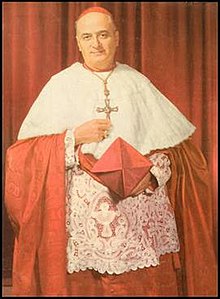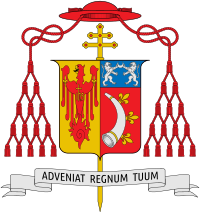Albert Gregory Meyer
Albert Gregory Meyer | |
|---|---|
| Cardinal, Archbishop of Chicago | |
 | |
| See | Chicago |
| Appointed | September 19, 1958 |
| Installed | November 16, 1958 |
| Term ended | April 9, 1965 |
| Predecessor | Samuel Stritch |
| Successor | John Cody |
| Other post(s) | Cardinal-Priest of Santa Cecilia in Trastevere |
| Orders | |
| Ordination | July 11, 1926 by Basilio Pompili |
| Consecration | April 11, 1946 by Moses E. Kiley |
| Created cardinal | December 14, 1959 by John XXIII |
| Rank | Cardinal-Priest |
| Personal details | |
| Born | March 9, 1903 |
| Died | April 9, 1965 (aged 62) Chicago, Illinois |
| Previous post(s) |
|
| Motto | ADVENIAT REGNUM TUUM (Thy kingdom come) |
| Coat of arms |  |
| Styles of Albert Meyer | |
|---|---|
 | |
| Reference style | His Eminence |
| Spoken style | Your Eminence |
| Informal style | Cardinal |
| See | Chicago |
Albert Gregory Meyer (March 9, 1903 – April 9, 1965) was an American prelate of the Roman Catholic Church. He served as archbishop of the Archdiocese of Chicago in Illinois from 1958 until his death in 1965, and was appointed a cardinal in 1959. He previously served as archbishop of the Archdiocese of Milwaukee in Wisconsin from 1953 to 1958 and as bishop of the Diocese of Superior in Wisconsin from 1946 to 1953.
Meyer was a strong advocate for racial justice and a firm supporter of Dr. Martin Luther King Jr. He was also a voice for religious tolerance and for the reconciliation of the Catholic Church with the Jewish people.
Biography[edit]
Early life and education[edit]
Albert Meyer was born in Milwaukee, Wisconsin, to Peter James Meyer, a grocer, and Mathilda (née Thelen) Meyer, both German immigrants.[1] The fourth of five children, he had two brothers and two sisters; one sister became a nun.[2][3] As a child, Albert Meyer would pretend to celebrate mass with a toy altar and a glass of water for the chalice of wine.[3]
Meyer received his early education under the School Sisters of Notre Dame at the parochial school of St. Mary's Parish in Milwaukee.[2] After attending Marquette Academy in Milwaukee for two years, he entered St. Francis Seminary in St. Francis, Wisconsin at age 14.[1] In 1922, he was sent by Archbishop Sebastian Messmer to Rome to continue his studies at the Pontifical North American College.[2]
Priesthood[edit]
On July 11, 1926, Meyer was ordained to the priesthood by Cardinal Basilio Pompili, at the church of Santa Maria sopra Minerva in Rome.[4] He then studied at the Pontifical Biblical Institute, obtaining a Doctorate in Holy Scriptures in 1930.[1][5]
After returning to Wisconsin in 1930, Meyer was appointed as curate at St. Joseph's Parish in Waukesha, Wisconsin. In 1931, he became a professor at St. Francis Seminary,[2] teaching religion, Greek, Latin, biblical archeology, dogmatic theology and scriptures.[1] When Monsignor Aloisius Muench was named bishop of the Diocese of Fargo, Meyer succeeded him as rector of St. Francis Seminary in 1937.[1] He was raised to the rank of domestic prelate, with the title of monsignor, in 1938, and also served as a chaplain and adviser to the local Serra Club.[2][5]
Bishop of Superior[edit]
On February 18, 1946, Meyer was appointed the sixth bishop of the Diocese of Superior by Pope Pius XII.[6] Meyer was consecrated on April 11, 1946, by Archbishop Moses E. Kiley, with Bishops Muench and William O'Connor serving as co-consecrators, in the Cathedral of St. John the Evangelist in Milwaukee.[7]
Archbishop of Milwaukee[edit]
Pius XII appointed Meyer as the seventh archbishop of the Archdiocese of Milwaukee on July 21, 1953. He was installed on September 24, 1953.[7]
Archbishop of Chicago[edit]
Pius Xll appointed Meyer as archbishop of the Archdiocese of Chicago on September 19, 1958.[8] He was installed on November 14, 1958.
On December 1, 1958, a fire broke out at Our Lady of the Angels School in Chicago, killing 92 students and three nuns. While visiting the hospital and morgue with Chicago Mayor Richard Daley, Meyer was overcome with grief. Cardinal Francis Spellman came to Chicago from New York City to support Meyer and Pope John XXIII sent a telegram of condolence to Meyer. After the fire, the archdiocese faced $44 million in lawsuits from the families of victims and survivors. After six years of settlement talks, Meyer decided to provide reparations to all the victims and survivors.[5]
Archbishop Meyer is featured in the 1958 film Decision for Happiness, produced by the Congregation of Sisters of St. Agnes.
In 1960, Meyer banned bingo games from parishes in the archdiocese in response to reports of corruption in the management of the games.[5] In January 1961, during riots in the African-American Bronzeville neighborhood of Chicago, Meyer made this public statement:
We must remove from the church on the local scene any possible taint of racial discrimination or racial segregation, and help provide the moral leadership for eliminating racial discrimination from the whole community.[5]
Cardinal[edit]
Despite skepticism,[9] Meyer was created Cardinal Priest of S. Cecilia by Pope John XXIII in the consistory of December 14, 1959. Church observers were surprised by his appointment as he had not spent much time in Rome after finishing his education.[5] He participated at the first three sessions of the Second Vatican Council, from 1962 to 1964, and sat on its Board of Presidency. During the council, Meyer showed himself to be of liberal tendencies[10][11][12] and was viewed as the chief intellectual among the participating American hierarchy.[13] The scholarly and often shy prelate supported religious liberty,[14] and strongly condemned racism, giving speeches alongside Martin Luther King Jr. and warning his clergy "not to foster the flame of racial hatred".[13] Meyer was also one of the cardinal electors in the 1963 papal conclave, which selected Pope Paul VI. Meyer, an occasional fisherman, once called fishing the "apostolic recreation", and was also known to attend a Milwaukee Braves baseball game.[15]
Death[edit]
Albert Meyer died at age 62 on April 9, 1965, at Mercy Hospital in Chicago three days after surgery to remove a malignant brain tumor.[5] The American Jewish Committee called Meyer"...one of the great liberal spirits of our time."[5]
He is buried in the cemetery of the University of Saint Mary of the Lake in Mundelein, Illinois.
See also[edit]
- Catholic Church hierarchy
- Catholic Church in the United States
- Historical list of the Catholic bishops of the United States
- List of Catholic bishops of the United States
- Lists of patriarchs, archbishops, and bishops
References[edit]
- ^ a b c d e Miranda, Salvador. "MEYER, Albert Gregory". The Cardinals of the Holy Roman Church.[better source needed]
- ^ a b c d e Thornton, Francis. "Albert Cardinal Meyer". Our American Princes.
- ^ a b "Stritch's Successor". Time. October 6, 1958. Archived from the original on January 31, 2011.
- ^ "Albert Gregory Cardinal Meyer". Catholic-Hierarchy.org.
- ^ a b c d e f g h "Albert Cardinal Meyer Is Dead;I Archbishop of Chicago Was 621; Leader of Largest A rchdioces in U.S. Urged Interfaith Ties at Council in Rome". The New York Times. April 10, 1965. ISSN 0362-4331. Retrieved May 5, 2022.
- ^ Diocese of Superior. Bishop Meyer (1946-1953).
- ^ a b "Albert Gregory Cardinal Meyer [Catholic-Hierarchy]". www.catholic-hierarchy.org. Retrieved May 5, 2022.
- ^ Archdiocese of Milwaukee. Archbishop Albert Gregory Meyer
- ^ Time. Pope's Progress December 1, 1958
- ^ Time. The Council's Prospects September 14, 1962
- ^ Time. Cum Magno Dolore October 23, 1964
- ^ Time. The Pope Runs the Church November 27, 1964
- ^ a b Holy Name Cathedral Parish. Resurrection, Restore & Renew April 8, 2007 Archived April 30, 2007, at the Wayback Machine
- ^ Time. The Right to Worship According to One's Conscience October 2, 1964
- ^ Time. Stritch's Successor October 6, 1958
External links[edit]
- 1903 births
- 1965 deaths
- 20th-century American cardinals
- Roman Catholic archbishops of Chicago
- American people of German descent
- Participants in the Second Vatican Council
- Religious leaders from Chicago
- Roman Catholic bishops of Superior
- Roman Catholic archbishops of Milwaukee
- Cardinals created by Pope John XXIII
- Pontifical Biblical Institute alumni
- Marquette University High School alumni







